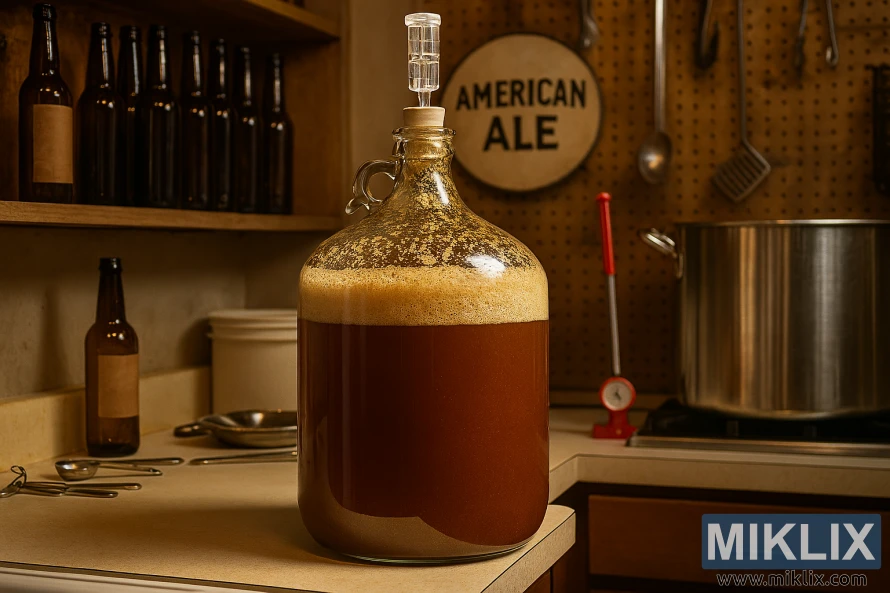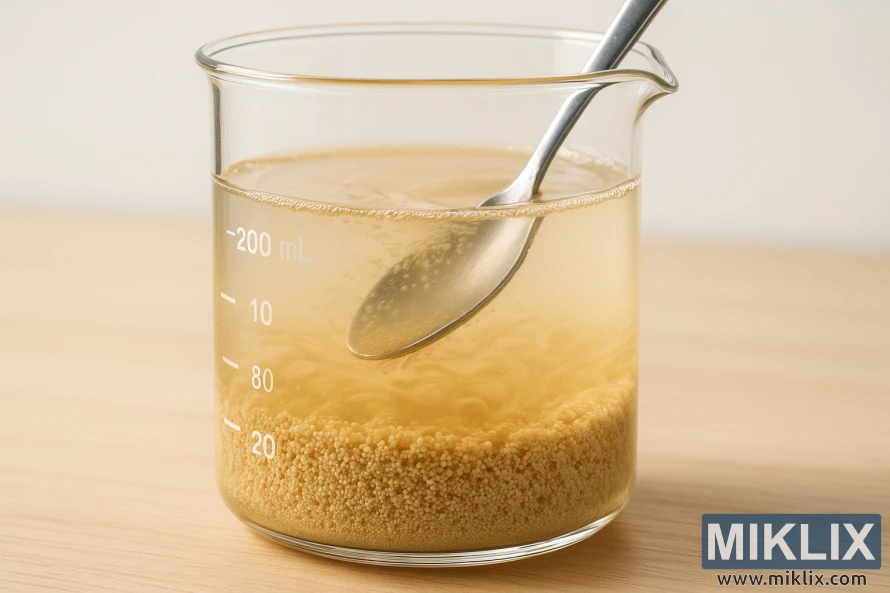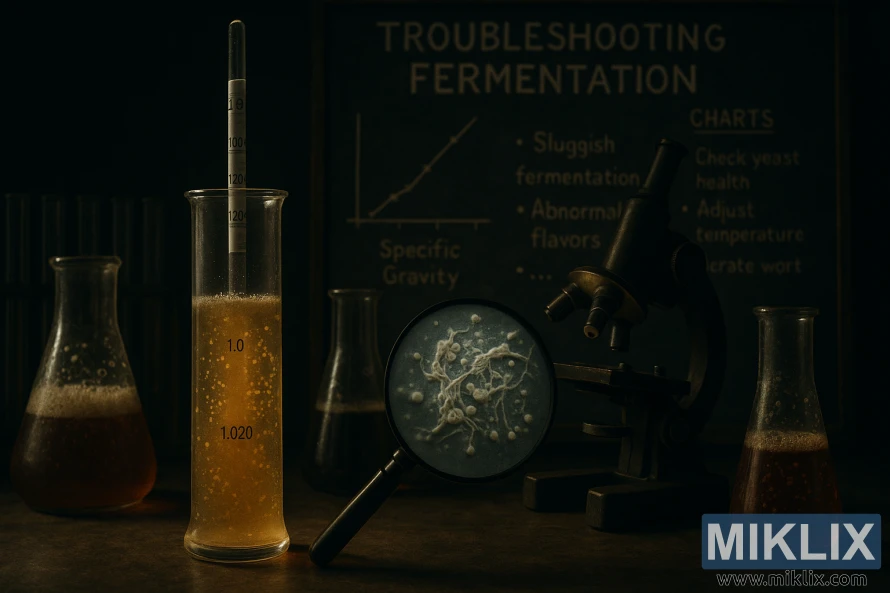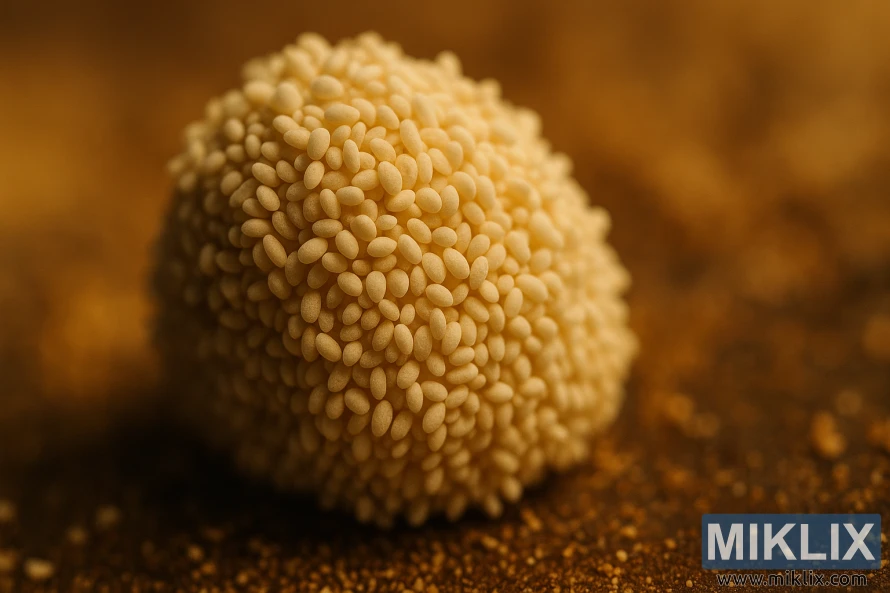Fermenting Beer with Fermentis SafAle US-05 Yeast
Published: July 20, 2025 at 7:41:40 AM UTC
Last updated: November 30, 2025 at 8:12:11 PM UTC
Homebrewing enthusiasts often seek a reliable yeast strain for high-quality beers. Fermentis SafAle US-05 yeast is a popular choice. It's known for its versatility and ability to ferment a wide range of ale styles. This yeast strain is celebrated for producing clean and crisp beers. It also creates a firm foam head. It's perfect for brewers aiming to create neutral ales. In this article, we'll dive into the characteristics, usage, and compatibility of Fermentis SafAle US-05 yeast. We'll provide valuable insights for homebrewers.

Key Takeaways
- Overview of Fermentis SafAle US-05 yeast strain
- Characteristics and benefits for homebrewing
- Compatibility with different ale styles
- Tips for optimal fermentation
- Common applications in homebrewing
Understanding Fermentis SafAle US-05 Yeast
Fermentis SafAle US-05 yeast is a top choice for craft brewers. It's celebrated for its ability to create well-balanced ales. This American ale yeast strain is prized for its neutral flavor and clean fermentation.
This dry yeast is a staple in the brewing world for its dependability. Its fame comes from its versatility in fermenting various ale styles. From pale ales to porters, it does so without adding strong yeast flavors.
Fermentis SafAle US-05 yeast boasts a high fermentation rate. It produces beers with low diacetyl levels, ensuring a crisp taste. Its flocculation properties are also noteworthy, aiding in beer clarity.
- Produces neutral and well-balanced ales
- Low diacetyl production
- Clean and crisp flavor profile
- Good flocculation properties
Understanding Fermentis SafAle US-05 yeast's characteristics and benefits is key. Brewers can then use this strain to craft high-quality American ales. These ales will meet consumer expectations, thanks to the yeast's clean flavor and balanced nature.
Technical Specifications and Performance Metrics
Understanding the technical specifications and performance metrics of Fermentis SafAle US-05 is key to achieving optimal brewing results. This yeast strain is known for its reliable performance and consistent brewing metrics. It's a favorite among brewers for these reasons.
Fermentis SafAle US-05 yeast has a medium to high attenuation, typically around 78-82%. This balance between fermentability and body is vital for producing beers with the desired alcohol content and flavor profile. The yeast's alcohol tolerance is approximately 9-11% ABV, making it suitable for a wide range of beer styles, from session ales to stronger brews.
The fermentation temperature range for Fermentis SafAle US-05 is a critical parameter that brewers need to control. Optimal fermentation temperatures typically range between 65°F to 75°F (18°C to 24°C). This range allows the yeast to perform at its best and produce the desired flavor compounds.
Key performance metrics for Fermentis SafAle US-05 include:
- Attenuation: 78-82%
- Alcohol Tolerance: 9-11% ABV
- Fermentation Temperature Range: 65°F to 75°F (18°C to 24°C)
These technical specifications and performance metrics highlight the versatility and reliability of Fermentis SafAle US-05 yeast. It's an excellent choice for brewers seeking consistent results. By understanding and optimizing these parameters, brewers can produce high-quality beers that meet their desired specifications.
Optimal Temperature Range and Fermentation Conditions
The performance of Fermentis SafAle US-05 is greatly affected by fermentation temperature and conditions. It excels at temperatures between 18-26°C. Yet, it's often fermented at the cooler end for a cleaner taste.
Controlling temperature is key when brewing with Fermentis SafAle US-05. Keeping the temperature within the optimal range is essential. It ensures the yeast ferments the beer well, creating the desired flavors and aromas.
Creating a proper fermentation environment goes beyond just temperature control. It also means keeping brewing equipment clean and sanitized. This step prevents contamination and helps the yeast work at its peak.
To get the best brewing conditions, brewers must closely watch the fermentation temperature. They should keep it steady throughout fermentation. Also, providing enough oxygen at the start can boost yeast growth and fermentation efficiency.
Flavor Profile and Beer Style Compatibility
Fermentis SafAle US-05 yeast offers a neutral flavor profile, allowing brewers to craft a wide range of beer styles. This characteristic is perfect for those aiming to create beers with unique flavor profiles without unwanted yeast notes.
Beers brewed with Fermentis SafAle US-05 yeast showcase a clean and neutral taste. This lets the malt and hop flavors take center stage. It's an excellent choice for beer styles where a subtle yeast presence is desired.
This yeast is versatile, suitable for brewing various styles like American Pale Ale, American IPA, American Stout/Porter, and American Amber Ale. Its ability to ferment well across different styles highlights its robust nature.
- American Pale Ale: US-05 contributes to a balanced flavor with a crisp finish.
- American IPA: Its neutral character lets hop flavors take over, creating a hoppy and aromatic IPA.
- American Stout/Porter: US-05 adds a smooth and rich texture, complementing the roasted flavors.
- American Amber Ale: The yeast imparts a malty and slightly sweet flavor, typical of this style.
To achieve the best flavor profiles with Fermentis SafAle US-05 yeast, brewers must consider several factors. These include fermentation temperature, pitching rate, and nutrient availability. By managing these variables, brewers can fully exploit this yeast's versatility.
In summary, Fermentis SafAle US-05 yeast is a reliable choice for brewers aiming to produce diverse beer styles. Its clean and neutral flavor profile makes it ideal for highlighting the natural flavors of ingredients.
Attenuation and Flocculation Properties
## Attenuation and Flocculation Properties
For brewers aiming at optimal beer clarity and flavor, grasping the attenuation and flocculation of Fermentis SafAle US-05 is key. This yeast boasts a medium to high attenuation, effectively consuming a large portion of sugars. This results in a dry finish in the final beer.
Its very good flocculation properties allow it to stay suspended during fermentation and then settle out. This contributes to clearer beer. Proper flocculation is essential for achieving the desired beer clarity and preventing off-flavors from yeast remaining suspended too long.
To optimize yeast flocculation and beer clarity, brewers should follow a few practices. First, maintaining proper temperature control during fermentation is critical. Extreme temperatures can harm yeast performance and flocculation. Second, ensuring adequate nutrient supply is vital for yeast health and function. Lastly, gentle handling of the beer during transfer and packaging minimizes disturbance to the yeast sediment, aiding in maintaining clarity.
- Monitor and control fermentation temperature.
- Provide adequate nutrients for yeast health.
- Handle beer gently during transfers.
By understanding and utilizing the attenuation and flocculation properties of Fermentis SafAle US-05 yeast, brewers can significantly improve the quality and consistency of their beers.
Best Practices for Rehydration and Pitching
To maximize the benefits of Fermentis SafAle US-05 yeast, brewers must grasp the significance of proper yeast rehydration and pitching. Adequate rehydration is vital for the yeast to reconstitute and initiate fermentation efficiently.
Fermentis SafAle US-05 yeast can be rehydrated in a minimum of 10 times its weight of sterile water or boiled and hopped wort. This should be done at a temperature ranging from 25 to 29°C. This step is critical for activating the yeast and ensuring a healthy fermentation process.
For optimal pitching, it's essential to ensure the yeast is fully rehydrated before adding it to the wort. The pitching rate must be calculated accurately, considering the wort's volume and specific gravity.
- Rehydrate yeast in sterile water or boiled and hopped wort.
- Maintain a rehydration temperature between 25 to 29°C.
- Pitch the yeast at the correct rate based on wort volume and specific gravity.
By adhering to these best practices for rehydration and pitching, brewers can enhance the performance of Fermentis SafAle US-05 yeast. This leads to successful fermentation and a high-quality brew.

Compatible Beer Styles and Recipe Recommendations
Brewers can craft a variety of tasty beers with Fermentis SafAle US-05. This yeast is perfect for making crisp pale ales and complex IPAs. It's versatile, fitting well with American Pale Ale, American IPA, and American Amber Ale.
Fermentis SafAle US-05 is favored for its neutral taste and clean, crisp beers. To make an excellent beer, brewers can try different hop varieties and malt profiles. For instance, combining US-05 with citrusy hops like Simcoe or Amarillo can create a refreshing pale ale.
- American Pale Ale: Use a mix of Cascade and Chinook hops for a balanced flavor.
- American IPA: Pair US-05 with aggressive hop additions, such as Citra or Mosaic, for a complex flavor profile.
- American Amber Ale: Use a combination of caramel malts and earthy hops to create a malty, balanced beer.
By honing brewing techniques and exploring various recipes, brewers can fully utilize Fermentis SafAle US-05 yeast. Whether brewing a simple pale ale or a complex IPA, US-05 is a dependable choice for high-quality beers.
Comparing SafAle US-05 with Other Yeast Strains
Fermentis SafAle US-05 yeast has become a favorite among brewers. But how does it compare to other yeast strains? Brewers need to know the similarities and differences between various yeast strains. This includes fermentation performance, flavor profile, and brewing techniques.
When comparing SafAle US-05 to other strains like SafAle US-04 and SafAle K-97, several factors are important. SafAle US-05 is known for its clean fermentation and high attenuation. This makes it a favorite for a wide range of beer styles. On the other hand, SafAle US-04 is preferred for its fruitier flavor profile. SafAle K-97 is noted for its ability to produce beers with a unique character.
In terms of brewing techniques, SafAle US-05 is versatile. It can be used for both ale and lager brewing with the right temperature adjustments. Its fermentation performance is robust, leading to consistent results across different batches.
- SafAle US-05: Clean fermentation, high attenuation, versatile.
- SafAle US-04: Fruity flavor profile, suitable for traditional ales.
- SafAle K-97: Unique character, suitable for experimental brews.
By understanding these differences, brewers can choose the optimal yeast strain for their specific brewing needs. This ensures the best possible outcome for their beer.
Storage and Viability Guidelines
Understanding the storage and viability guidelines for SafAle US-05 yeast is key to achieving optimal brewing results. Proper storage conditions are vital for maintaining the yeast's viability and performance.
Fermentis SafAle US-05 yeast has a shelf life of 36 months from the production date. It's advised to store it below 24°C (75°F) if used within 6 months. For longer storage, refrigeration between 4°C to 8°C (39°F to 46°F) is recommended.
Here are some best practices for storing Fermentis SafAle US-05 yeast:
- Keep the yeast in its original, unopened packaging to prevent contamination.
- Store the yeast in a cool, dry place, away from direct sunlight.
- If stored at room temperature, ensure it is below 24°C (75°F) for short-term storage.
- For extended storage, refrigeration is recommended to slow down the degradation process.
Maintaining the viability of the yeast is critical for successful fermentation. Always check the production date and follow the recommended storage conditions. This ensures the yeast remains viable and effective for brewing.
Troubleshooting Common Fermentation Issues
Addressing fermentation problems is key to achieving top-notch beer quality, even with a reliable yeast like Fermentis SafAle US-05. Despite its dependability, brewers may face issues like slow fermentation or unwanted flavors.
To keep yeast in prime condition and fermentation running smoothly, monitoring temperature, pitching rates, and wort composition is essential. Staying within the recommended ranges for these factors can often solve many common problems.
Here are some common fermentation issues and how to tackle them:
- Slow fermentation: Check temperature and pitching rates, and ensure adequate wort nutrients.
- Off-flavors: Verify proper sanitation and handling practices to prevent contamination.
- Stuck fermentation: Monitor specific gravity and adjust temperature or add nutrients as needed.
Understanding the reasons behind common fermentation issues and taking corrective steps can significantly improve fermentation outcomes. This way, brewers can consistently produce high-quality beers using Fermentis SafAle US-05 yeast.

Advanced Brewing Techniques with US-05
Exploring the realm of Fermentis SafAle US-05 yeast opens up new horizons for brewers. This yeast is not just for traditional brewing. It also excels in advanced techniques like sour brewing and wild fermentation.
Using Fermentis SafAle US-05 offers brewers a wide range of possibilities. They can fine-tune yeast performance by tweaking temperature, nutrient levels, and pitching rates. This allows for the creation of unique flavor profiles.
Advanced brewing techniques with US-05 include:
- Blending yeast strains to create complex flavor profiles
- Using US-05 in mixed fermentation setups for sour beers
- Experimenting with different fermentation temperatures to influence ester and phenol production
By honing these techniques, brewers can expand their beer's possibilities. They can explore new dimensions with Fermentis SafAle US-05 yeast.
Commercial Brewery Applications
Commercial breweries depend on Fermentis SafAle US-05 for its strong fermentation and adaptability in large-scale brewing. This yeast is a key player in creating top-notch beers across many styles.
The success of Fermentis SafAle US-05 in commercial brewing stems from its dependable performance. It excels in a variety of fermentation conditions. To optimize its use, breweries focus on:
- Proper yeast management practices, such as rehydration and pitching rate control
- Careful monitoring of fermentation temperature and specific gravity
- Scaling fermentation processes while maintaining consistency
Commercial breweries also value the yeast's attenuation and flocculation properties. These traits enhance the beer's character and clarity. By understanding and using these properties, brewers can craft a wide variety of beer styles with precision.
To get the most out of Fermentis SafAle US-05, commercial breweries should prioritize yeast health and fermentation conditions. This includes keeping the yeast in optimal storage conditions and maintaining consistent pitching rates.
By implementing these strategies, commercial breweries can achieve consistent, high-quality fermentation results. This boosts their beer's market competitiveness.
Conclusion
Fermentis SafAle US-05 stands out as a versatile and dependable yeast strain for brewers. Its consistent fermentation performance has made it a favorite among many. It's a testament to its reliability and effectiveness in various brewing scenarios.
When evaluating yeast selection, brewers must consider both the advantages and disadvantages of SafAle US-05. This yeast is known for its neutral flavor, making it suitable for a wide array of beer styles. This versatility is a significant plus for brewers looking to experiment with different brews.
To ensure brewing success with SafAle US-05, brewers should adhere to best practices. Proper rehydration and pitching techniques are essential. Maintaining optimal fermentation conditions is also critical for achieving the best results.
Understanding the characteristics and capabilities of Fermentis SafAle US-05 empowers brewers to make informed decisions. This knowledge allows them to optimize their brewing process. As a result, they can consistently produce high-quality beers.

Further Reading
If you enjoyed this post, you may also like these suggestions:
- Fermenting Beer with Wyeast 2000-PC Budvar Lager Yeast
- Fermenting Beer with Wyeast 1098 British Ale Yeast
- Fermenting Beer with Lallemand LalBrew Köln Yeast
